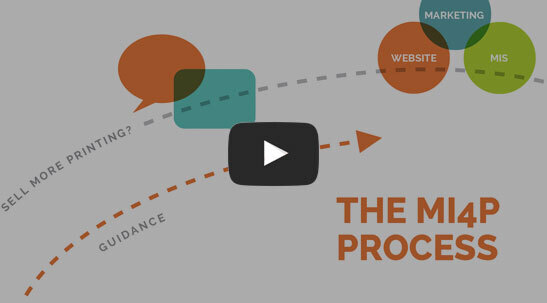And, remember, if you subscribe to social marketing content from Marketing Ideas For Printers, don’t forget to add and customize the provided text. This often gets overlooked in the Facebook content, especially, and printers skip to only posting the articles. Be sure you’re copying, customizing, and pasting engaging text along with the article link provided.
2. Not Promoting the Useful Content on Your Website
More than likely, your website is a goldmine of useful information for your print buyers, but they don’t know about it yet! (P.S. If your website is not already packed full of relevant content, click here for a quick and easy solution.)
This is easily solved by regularly picking out and promoting content from your website via social media and email marketing. Here’s an example of one week’s worth of content from just ONE page on your website’s Help Center:
- Monday: Have you ever wondered why the image you pulled from your website doesn’t look good in print? It all comes down to correct image resolution. It’s an easy fix! Take a look at these examples… http://bit.ly/image-resolution
- Tuesday: Here’s a quick and fun printing quiz for you: 1. What does the “K” stand for in CMYK? 2. Besides CMYK, there’s another color mode that features three letters; what letters are they? You can check yourself here… http://bit.ly/color-mode
- Wednesday: There are good files for printing and bad files for printing, and these three things usually determine it. Any guesses? See if you’re right here… http://bit.ly/good-vs-bad-files
- Thursday: If your printed piece calls for a border along its edge, don’t forget this key piece! Here’s a hint: When ink runs all the way to the edge of a printed piece, it’s called a [_____]. Comment below, and we’ll give $5.00 off to the fifth person with the right guess! We’ll even let you find the answer at… http://bit.ly/missing-piece-border
- Friday: Ok, let’s see what the social media crowd says: What font size is too small for you to read in print? You’d be surprised how often important details get missed when the font is too small. When in doubt, follow this guideline… http://bit.ly/font-text-sizes
Now, imagine if you went page by page on your website. In just the Ideas Collection alone, featuring Print, Design, Tech, and Marketing tips, you could easily create 80+ social media posts!
Why does this matter? Because with every click from social media, you are welcoming a new visitor to your website. If you’re not sending out invitations by providing opportunities for your audience to come to your website, you’ll miss out on website traffic that’s ripe for the taking!
3. Failing to Connect the Online Dots
You might not realize this, but you are the traffic guide for your website visitors, and ensuring you’ve created a clear path for your visitors is a critical component of increasing your traffic.
Think of it like this: If your visitor lands on your blog as part of their online journey, do they know where to go next? Is there a clear path to guide them to their next destination, or are you leaving them lost and unsure?
A scene from Disney’s 1998 classic, A Bug’s Life, illustrates this “I’m lost” concept beautifully. Take a look:
Don’t leave your visitors feeling like these ants, with a big, ole leaf on your web page. Make the path obvious. Here are a couple of easy connection examples you can start making today.
Start with your blogs. You need to add a linked connection IN EVERY BLOG to bring the reader back to your website. For example, if you subscribe to the blog content from Marketing Ideas For Printers, when posting, you’ll want to add a next step, call-to-action at the bottom of the blog, such as “Ready to take the tips you’ve learned here and apply them to your printed brochures? Click here to start your next brochure project.” Then, add a link to your brochure product page or DesignEdit if you want them to start designing their project. Either way, the objective is to move the reader from the blog to the next step on your website by linking to the next step.
Interlinking on key terms. You can also add interlinking links to your blogs by linking on key terms within the blog. That’s a mouthful and sounds complicated, but it’s not. Here are some examples of what this could look like:
- Sample blog text: “As a time-tested commodity, brochures offer an easy-to-follow layout that builds instant connections with all types of people.”
- Add an interlinking link to the word “brochures” back to your brochure product page.
- Sample blog text: “Unique, eye-catching folds offer so much room to flex your creativity! When creating your next masterpiece, here are some fun print folds to consider:”
- Add an interlinking link to the words “print folds” back to your bindery and finishing web page or another article within the Ideas Collection that talks about folding.
- Sample blog text: “For a simpler direct mail option without a list, consider using Every Door Direct Mail. Here you can target customers by demographics like age, household size, income, zip code, etc.”
- Add an interlinking link to the words “Every Door Direct Mail” and link back to your white paper that covers EDDM.
Interlinking between articles like this and clustering your content not only helps your visitor know where to go next, but it also helps search engines when crawling your website and increases your SEO effectiveness.
Related articles:




